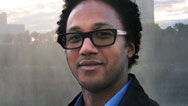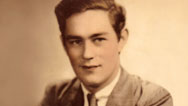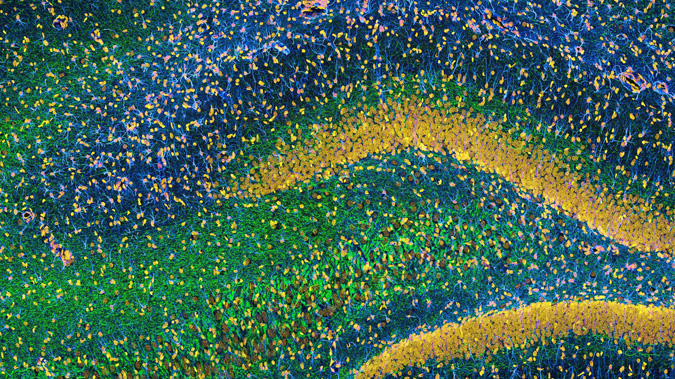
How Memory Works
Neurobiologists are honing in on how memories form, and then finding ways to erase them. Airing August 25, 2009 at 9 pm on PBS Aired August 25, 2009 on PBS

Program Description
Transcript
How Memory Works
PBS Airdate: August 25, 2009
NEIL DeGRASSE TYSON: Most of us hold in our minds, memories of our lives, so vivid that when we recall them, they seem real and indelible. They're an essential part of who we are. But as we explore the mechanics of the brain, we're starting to learn exactly what these memories are made of. And it turns out a lot of it boils down to chemistry.
As correspondent Chad Cohen reports, researchers are discovering the precise molecules that can create memories, as well as the molecules that can erase them forever.
CHAD COHEN (Correspondent): This is the brain that, more than any other in history, has allowed scientists to make sense of your brain. For 82 years, it resided in the head of a man named Henry Gustav Molaison, better known as H.M. He was, perhaps, the most-studied patient ever. And that didn't end when he died last year.
With H.M.'s permission, neuroanatomist Jacopo Annese went to work, dissecting his brain into 3,000 slices.
JACOPO ANNESE (The Brain Observatory/University of California, San Diego): You can imagine the brain being like a book, and our tissue slices are the pages of this book. The only catch is that the slices are transparent. So you cannot really see anything until you use a lot of obscure chemical processes to reveal the features in the tissue. Eventually, the entire book will be completely stained. And they will tell us the story of this brain.
CHAD COHEN: It's a story that begins with epilepsy, epilepsy so severe that by 1953, H.M. had reached his breaking point.
SUZANNE CORKIN (Massachusetts Institute of Technology): He had to stop working because of the frequency of his seizures. It was just too dangerous. So he was basically at home with his parents. His life was on hold.
CHAD COHEN: In desperation, H.M. let surgeon William Scoville remove slivers of brain on either side of his head, each containing a seahorse-shaped structure called a hippocampus. This might have seemed reasonable at a time when we knew almost nothing about memory. And it did quiet his seizures, though at a terrible cost.
SUZANNE CORKIN: Do you know what you did yesterday?
HENRY GUSTAV MOLAISON (Epilepsly Patient/File Footage): No, I don't.
SUZANNE CORKIN: How about this morning?
HENRY MOLAISON: That, I don't know myself. I can't tell you because I don't remember.
CHAD COHEN: H.M.'s condition might have seemed like simple dementia, but as neuroscientist Brenda Milner discovered, it was anything but.
BRENDA MILNER (Montreal Neurological Institute): He would say, "Right now it's like waking from a dream. Right now everything is clear. But what happened just before?"
CHAD COHEN: Milner found that H.M. had a normal I.Q. He could crack jokes, solve puzzles. Even, to some extent, remember.
ERIC KANDEL (Columbia University): So H.M. could remember everything that happened prior to the operation. He could remember the trauma of his childhood. He could remember going to elementary school, to high school, working in the assembly plant.
CHAD COHEN: What he couldn't do was hold on to new information for more than a few minutes. In a moment of insight, Milner concluded the hippocampus must make long-term memories out of short-term ones.
SUZANNE CORKIN: That was a groundbreaking finding because it showed that the ability to establish long-term memories is localized to this tiny area in the brain.
CHAD COHEN: If H.M. had contributed nothing more, his fame would have been assured. But he would go on inspiring discoveries for decades. The next involved a pencil, a mirror and, again, Brenda Milner.
ERIC KANDEL: She did this brilliant test in which she had H.M. draw the outlines of a star without looking at the star, but looking into a mirror.
CHAD COHEN: It's hard, at first, to draw within the lines, but could H.M., like people with normal memory, learn to do it with practice?
After three days and 10 trials, his performance was nearly perfect.
BRENDA MILNER: Well, he said, "I thought this would be difficult, but it looks as though I've done pretty well." He had no memory of all these learning trials that he had been through, and the beautiful learning, that was the real contrast.
CHAD COHEN: So H.M. could remember a motor skill, but not recall a fact or an event. It was a key discovery, because it showed there were different kinds of memory, dependant on different parts of the brain.
But what is a memory, anyway?
Nerve cells communicate by sending electrical signals, which trigger the release of chemicals across tiny gaps called synapses. As one cell speaks to another, chemical changes at the synapse make it easier for the signals to pass. If only a few signals are sent, this transformation among a network of cells is temporary, resulting in a short-term memory. But if the signals keep coming, changes at the most active synapses become permanent, forming a long-term memory.
ERIC KANDEL: So long-term memory actually involves an anatomical change in the brain. So, as I like to say, if you remember anything about this conversation tomorrow, it's because you will have a slightly different head than you had today.
CHAD COHEN: But what maintains a long-term memory? How can you recall something that you may not have thought about for 20 years?
Neuroscientists Todd Sacktor and Andre Fenton think the answer may lie in a molecule called PKMzeta that accumulates at synapses as memories form.
ANDRE FENTON (SUNY, Downstate Medical Center): PKMzeta acts as glue, if you will, for fixing the connections amongst the neurons that were active together. So that later in time, those neurons are bound together and permanently bound together, and can become active again to recall the experience.
CHAD COHEN: To assess the molecule's importance, Fenton set up an experiment that would give the rat a memory. He placed it on a revolving table, where in one area it would receive a mild shock.
ANDRE FENTON: There's the rat, and he's approaching the shock zone. He's beginning to move a little bit but looks like he's going to enter the shock zone. He's gotten shocked, and he's just run away. He's approaching it right now.
CHAD COHEN: Soon, the rat always avoided the shock zone.
ANDRE FENTON: So when the rat stays away from a particular area, we can imagine that he has remembered where he was shocked.
CHAD COHEN: Then Fenton injects the rat's hippocampus with a chemical called ZIP, known to undo the effect of PKMzeta.
ANDRE FENTON: And what we observed, which was quite remarkable, was the rat acted as though it had forgotten completely where the shock zone was. And it explored the arena as if it was in the arena for the first time.
Just got shocked.
CHAD COHEN: Yet the rat could learn once again to avoid the shock zone.
ANDRE FENTON: So we hadn't damaged the rat's brain. We hadn't broken its ability to learn anything. What we had simply done was specifically erased the memory for that shock zone.
CHAD COHEN: Without PKMzeta, the rat cannot maintain a long-term memory. While this is not the only molecule active at synapses, it does appear we may have found a crucial ingredient of memory, one that explains how a three-pound lump of flesh can store, indefinitely, vivid recollections of everything from birthdays to weddings, to episodes of NOVA scienceNOW.
Meanwhile, the man who launched the modern era of brain research is making his final contribution. Three thousand glass slides of H.M.'s brain are being posted on the Internet, where researchers will be able to examine them down to the level of individual neurons.
And what would H.M. have thought about all this?
HENRY MOLAISON: The way I figure it is what they find out about me helps them to help other people.
On Screen Text: We asked scientists to critique our depictions of neurons.
1. The synapse: a neural junction used for communication between neurons.
Too far apart.
Closer.
Even closer.
Alright.
Also...
2. Why all the flashing lights? Electricity doesn't zap through your house like this. And it doesn't in your brain, either. Good thing.
Broadcast Credits
How Memory Works
- Produced, Directed and Edited by
- Sarah Holt
NOVA scienceNOW
- Executive Producer
- Samuel Fine
- Executive Editor
- Neil deGrasse Tyson
- Senior Series Producer
- Vincent Liota
- Senior Producer
- Julia Cort
- Supervising Producers
- Stephen Sweigart
Joey David Jovanovich - Senior Editor and Colorist
- David Chmura
- Online Editor
- Laura Raimondo
- Senior Researcher
- Sharon Kay
- Associate Producer
- Fran Laks
- Assistant Editors
- Rob Chapman
Tung-Jen (Sunny) Chiang - Graphic Design
- Brian Edgerton
- Compositor & Animator
- Yunsik Noh
- Music
- Rob Morsberger
- Sound Mix
- Bill Cavanaugh, RazorMix, Inc.
- Assistant to Neil deGrasse Tyson
- Elizabeth Stachow
- NOVA scienceNOW Series Animation
- Edgeworx
- Correspondent for Memory segment
- Chad Cohen
- Correspondent for Memory segment
- Chad Cohen
- Correspondent for Gangster Birds segment
- Doug Quade
- Researcher, Creative Consultant for Memory Segment
- Ethan Herberman
- Associate Producers
- Julie Crawford
Melanie Cunningham - Camera
-
Chad Baron
Christine Burrill
Thomas Danielczik
Marten Kaufman
Edward Marritz
Michael D. McClare - Sound Recordists
- Chad Baron
Giovanni DiSimone
Bryan Kweskin
Mark Mandler
Jerry Rose - Animation
- Sputnik Animation
James LaPlante
Doug Quade
Noisy Neighbor Productions
David Grubin Productions
Philip Pfeifer, Insight Animations - Stills Animation
- Dan Nutu
- For Lone Wolf Documentary Group
-
- Executive Producer
- Kirk Wolfinger
- Production Manager
- Donna Huttemann
- Archival Material
- Antler Ridge Wildlife Sanctuary
BBC Motion Gallery
John Benson
Miquel Bosch
Corbis Images
Suzanne Corkin
Eric Kandel
The Macaulay Library at the Cornell Lab of Ornithology
Brenda Milner
NASA
Brian Salzberg - Special Thanks
-
Jeffrey Burcher
Courtney Emmett
Bruce Fischl
Itzhak Fried, UCLA
David Glanzman, UCLA
Goddard Space Flight Center
Johnson Space Center
Kennedy Space Center
Athinoula A. Martinos Center for Biomedical Imaging
Montreal Neurological Institute
National Aeronautics and Space Administration Headquarters, Washington D.C.
Susan D. Phipps
Space Telescope Science Institute
Larry Squire, UCSD
Allison Stevens
The Crew of STS-125
Andre van der Kouwe
Benjamin Whatley - Neil deGrasse Tyson
- is director of the Hayden Planetarium in the Rose Center for Earth and Space at the American Museum of Natural History.
- NOVA Series Graphics
- yU + co.
- NOVA Theme Music
- Walter Werzowa
John Luker
Musikvergnuegen, Inc. - Additional NOVA Theme Music
- Ray Loring
Rob Morsberger - Post Production Online Editor
- Spencer Gentry
- Closed Captioning
- The Caption Center
- NOVA Administrator
- Mykim Dang
- Publicity
- Carole McFall
Eileen Campion
Victoria Louie
Karinna Sjo-Gaber
Karen Laverty - Marketing
- Steve Sears
- Researcher
- Kate Becker
- Senior Researcher
- Gaia Remerowski
- Production Coordinator
- Linda Callahan
- Paralegal
- Sarah Erlandson
- Talent Relations
- Scott Kardel, Esq.
Janice Flood - Legal Counsel
- Susan Rosen
- Production Assistant
- Ryan Murdock
- Post Production Assistant
- Darcy Forlenza
- Associate Producer, Post Production
- Patrick Carey
- Post Production Supervisor
- Regina O'Toole
- Post Production Editors
- Rebecca Nieto
Jason York - Post Production Manager
- Nathan Gunner
- Compliance Manager
- Linzy Emery
- Development Producer
- Pamela Rosenstein
- Business Manager
- Joseph P. Tracy
- Senior Producer and Project Director
- Lisa Mirowitz
- Coordinating Producer
- Laurie Cahalane
- Senior Science Editor
- Evan Hadingham
- Senior Series Producer
- Melanie Wallace
- Managing Director
- Alan Ritsko
- Senior Executive Producer
- Paula S. Apsell
This material is based upon work supported by the National Science Foundation under Grant No. 0638931. Any opinions, findings, and conclusions or recommendations expressed in this material are those of the author(s) and do not necessarily reflect the views of the National Science Foundation.
NOVA scienceNOW is a trademark of the WGBH Educational Foundation
NOVA scienceNOW is produced for WGBH/Boston by NOVA
© 2009 WGBH Educational Foundation
All rights reserved
- Image credit: (brain animation) © WGBH/NOVA
Participants
- Jacopo Annese
- The Brain Observatory, University of California, San Diego
- Suzanne Corkin
- Brain & Cognitive Sciences, Massachusetts Institute of Technology web.mit.edu/bcs/people/corkin.shtml
- Neil deGrasse Tyson
- Astrophysicist, American Museum of Natural History www.haydenplanetarium.org/tyson/profile/bio
- André Fenton
- NYU
- Eric Kandel
- Columbia University
- Brenda Milner
- McGill University
Preview
Full Program | 10:15
Full program available for streaming through
Watch Online
Full program available
Soon









